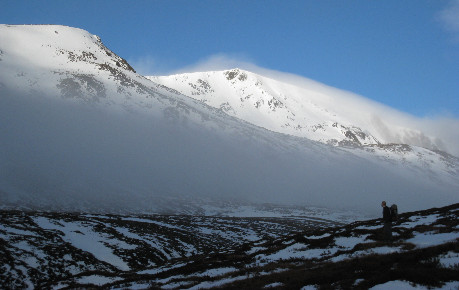Youíve done as recommended and checked the mountain weather forecasts covering the area for your planned journey.
But what does it all mean?
You shouldnít make plans and then look at a forecast just to see what weather youíre likely to get: you should use the forecast to make your plans. Depending on the forecast you may even completely change your plan and head west rather than east, or vice versa, to take advantage of the best conditions.
Whether or not itíll rain or snow and if itíll be sunny are probably what most people look at, but the forecast will tell you much, much more.
A major factor is the wind. How strong is it? What direction is it coming from? Is it easing or strengthening as the day wears on?
In a strong wind Ė and anything over 35mph will affect the balance of a fit, strong adult Ė you may want to avoid narrow ridges, or tricky terrain where losing your footing could lead to injury. You will want to have the wind behind you as much as possible, so the wind direction may well affect your own direction of travel. If itís strengthening throughout the day you might decide to go high in the morning and walk out lower in the glen, while if the wind is easing you may decide to walk through the glen in the morning and return over the hill in the afternoon when the wind will be less.
Wind also combines with rain to make very unpleasant conditions, especially if you are trying to walk into the wind. Hypothermia can be a danger in these conditions.
Yes rain. It's not all about the white stuff in a Scottish winter and rain can give some of the most challenging conditions. Even though the temperature isn't so low, rain will wet your clothes and increase your rate of heat loss, making hypothermia a risk. Rainís not a showstopper the way wind can be though, and with a good set of waterproofs (jacket and trousers) thereís no reason you canít enjoy a good day out on the hills. But heavy or prolonged rain - or a major thaw - can have a big effect on river and stream levels, making them harder or even impossible to cross. So make sure you make allowances and remember: a stream which you crossed on the way out may be completely impassable by the time you return. If there has been heavy rain, or heavy rain is forecast, it is wise to plan a route that either utilizes bridges or crosses glens high up at the watershed.
We need the snow to fall to provide us with the winter conditions we love, but heavy snowfall on the day of your trip can be rather inconvenient. It can cover up tracks and affect visibility in the air, possibly creating white-out conditions where it's impossible to differentiate between the ground and the sky, making navigation extremely difficult even for experts.
Heavy snow can also build up very quickly, especially if there's a wind along with it, and underfoot conditions can grow steadily worse as your day progresses, making walking harder and increasing any avalanche danger.
Temperature generally decreases with height, and the reduction can be considerable. Mountain-specific forecasts will give you the expected temperature at Munro height, so youíll know what to expect and how many additional layers to carry.

Once you switch on to the idea of using the weather forecast to make your plans you realise how much useful information there is Ė and you increase your chances of having a good day out, because youíve gone where thereís the best chance of usable weather and youíve planned your route to take best advantage of that weather.
The most commonly used mountain weather forecasts are the Mountain Weather Information Service (MWIS) and the Met Office, and it really is worth checking both.
MWIS is good for getting a general picture of the weather over a wide region for the current day and two days ahead. The Met Office forecast allows you to drill deeper down for more precise information, getting a forecast for a specific hill and on how the weather is expected to change in three-hour intervals through the day. That detail is great for detailed planning, but sometimes itís harder to get the general picture which you can get from MWIS, which also has useful commentary on the effects of the expected weather.
A good guide to developing snow conditions on the ground can be found on the Scottish Avalanche Information Service daily blogs through the forecast season.
It's common on Facebook and other social media to see people asking about conditions on the hills they're aiming for the next day - or even the next week. Seeking advice from people whose level of knowledge you don't know is not wise. Even people who with the best of intentions assure you that "I was up there yesterday and it was fine - didn't need crampons or ice axe" could be offering fatal advice. It could be that they were themselves taking risks and simply 'got off with it'; they could be far more skilled than you and able to do safely what you cannot; or, crucially, conditions could have changed drastically overnight. Stick to advice which comes from sources which you know to be authoritative.